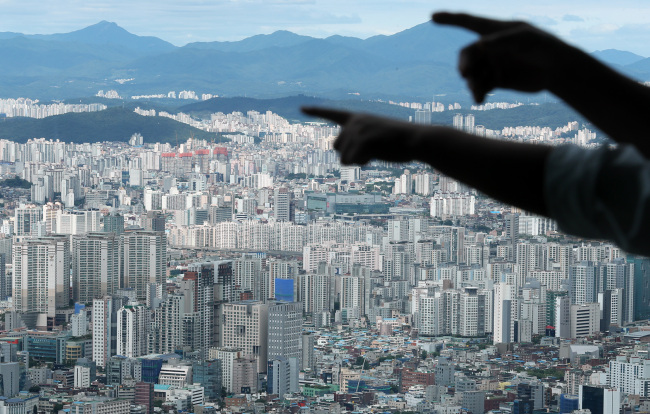A simultaneous downturn in economic indicators raises the possibility of the Korean economy weakening in the second half to the extent of making it hard to achieve the official 2018 growth target of 2.9 percent.
Preliminary data released by the Bank of Korea last week showed Asia’s fourth-largest economy grew 0.7 percent on-quarter in the April-June period, decelerating from a 1 percent rise in the first quarter.
Finance Minister Kim Dong-yeon, who doubles as deputy prime minister for economic affairs, described the growth estimate by the central bank as roughly in line with the government’s forecast, saying the economy does not seem to have deviated from its recovery path.
The on-quarter growth of 0.7 percent may not necessarily be seen as discouraging. Calculated into an annualized rate, it is equivalent to the country’s yearly growth potential, which is estimated to be between 2.8 and 2.9 percent.
But scrutiny into economic indicators showed the second-quarter growth managed to remain in the positive territory as a simultaneous slump in consumption, investment and exports was offset by a decrease in imports, which are factored into reducing growth.
According to the latest figures from the central bank, private consumption increased 0.3 percent in the April-June period, down from 0.7 percent in the previous three months.
Facility investment and construction investment, which grew 3.4 percent and 1.8 percent in the first quarter, shrank 6.6 percent and 1.3 percent, respectively, in the second quarter.
“Slumping private consumption amid declining investment means that the vitality of the overall economy is being sapped,” said Ju Won, an economist at the Hyundai Research Institute, a private think tank.
The country saw the increase in exports, which have bolstered its economic growth in the past years, slow from 4.4 percent in the first quarter to 0.8 percent in the following three months. Aside from a rise in the overseas shipment of semiconductors, Korea’s exports recorded a negative growth in the April-June quarter.
What enabled the Korean economy to grow in the second quarter amid the slowdown in domestic demand and exports was a 2.6 percent decrease in imports.
In particular, the import of manufacturing equipment fell sharply as local firms cut or suspended planned investments amid deteriorating business conditions at home and abroad.
BOK analysts say the 2.9 percent growth target for this year could be achieved if the growth rate reaches between 0.82 and 0.94 percent in the third and fourth quarters.
But many economists express more cautious views.
Sung Tae-yoon, a professor of economics at Yonsei University, said the growth trend should be conceived to have taken a downward turn as local companies reduced investments out of concerns over future uncertainties.
According to a recent survey by the Korea Chamber of Commerce and Industry, the business sentiment index for the local manufacturing industry remained at 87 for the third quarter, marking a 10 percentage point drop from the previous quarter.
The estimate of the combined operating profits of 239 major listed Korean firms for the July-September period, based on a consensus among local brokerage houses, dropped from 56.2 trillion won ($50.3 billion) three months ago to 55.5 trillion won last week.
Experts note planned US interest rate hikes and an escalating trade war between the US and China will further hold back Korean companies from increasing investments.
Domestic demand, which has not shown signs of rebounding despite massive fiscal spending over the past year, is expected to continue to remain sluggish in the second half as employment conditions and consumer sentiment worsen.
Earlier this month, the government revised down its outlook for on-year increase in the number of newly employed people this year from 320,000 to 180,000. Economists say the lowered target may still prove hard to reach as long as President Moon Jae-in’s administration adheres to its anti-business policies.
Consumer sentiment index remained at 101 in July, the lowest in 15 months.
Casting a shadow on the prospect of the country’s exports is the forecast that global demand for chips will decrease in the coming years. Korea’s overreliance on the semiconductor sector for growth is reflected on the fact that a slowdown in investments by local chipmakers has resulted in a reduction in total industrial investment.
Shin Se-don, a professor of economics at Sookmyung Women’s University, said that if exports slumped further amid sluggish domestic demand, this year’s growth rate would even fall short of 2.8 percent, a figure suggested by most local private research institutes.
The weakening traction of growth is set to detach Korea further from the global growth trend. The International Monetary Fund predicted in its latest World Economic Outlook report published earlier this month that the global economy would expand 3.9 percent this year.
In a parliamentary session a day after the BOK released the data for the second quarter, Finance Minister Kim said the government would seek to reinvigorate the economy for the rest of the year through an extra fiscal spending worth 4 trillion won and a cut in consumption tax on cars.
He also told an earlier meeting with reporters that he was eager to meet with corporate leaders to help foster innovative growth.
“I am ready to listen to what they want and to discuss measures to speed up deregulation,” he said.
Economists say it would be hard to shore up growth without substantial progress in regulatory reforms and technological innovations.
By Kim Kyung-ho (
khkim@heraldcorp.com)






![[Herald Interview] 'Trump will use tariffs as first line of defense for American manufacturing'](http://res.heraldm.com/phpwas/restmb_idxmake.php?idx=644&simg=/content/image/2024/11/26/20241126050017_0.jpg)
![[Exclusive] Hyundai Mobis eyes closer ties with BYD](http://res.heraldm.com/phpwas/restmb_idxmake.php?idx=644&simg=/content/image/2024/11/25/20241125050044_0.jpg)
